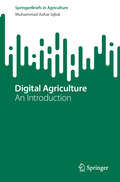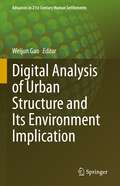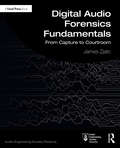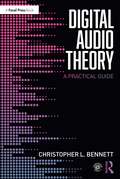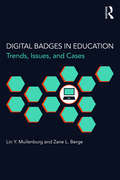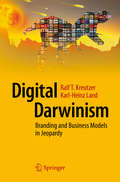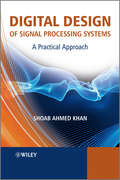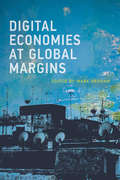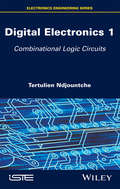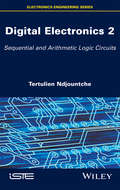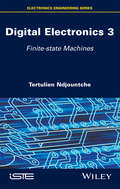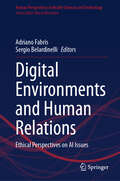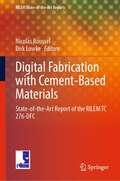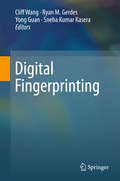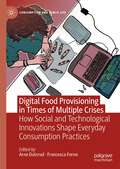- Table View
- List View
Digital Agriculture: An Introduction (SpringerBriefs in Agriculture)
by Muhammad Azhar IqbalThe success of modern-day agriculture lies in the digitalization of agricultural systems. The primary aim of this book is to provide a starting point to understand the fundamentals and design of digital agriculture systems with reference to the enabling technologies that deal with the production, improvement, and protection of crops/plants and livestock. The other associated objectives of this book include the explanation of the design and deployment of IoT-based digital agriculture systems in such a simple way that agriculture students understand straightforwardly. Therefore, this book is an effort to partially fill the gap associated with the understanding of the development and deployment of digital agriculture systems (including both precision and smart farming). We believe that with the provided details of enabling technologies and their usage in digital agriculture systems, agriculture students will find it easier to comprehend the designing of small-/large-scale IoT-based digital agriculture systems. This book provides insight into different technologies, architectures, and case studies that will ultimately help students to understand the concept of Digital Agriculture and its related applications. It enables students to realize the importance of open issues and future challenges of digital agriculture systems.
Digital Analysis of Urban Structure and Its Environment Implication (Advances in 21st Century Human Settlements)
by Weijun GaoThis book provides new information to understand the relationship between urban development and environmental change to the reader. How to create a sustainable and livable urban environment and realize the sustainable development goals (SDGs) of the United Nations (UN) is one of the biggest challenges in this century, even in the next centuries. The covered subject areas of this book aim at finding a way to push SDGs forward by collecting the related knowledge between urban development and its environmental implication. Specifically, the book focuses on UN SDGs 9 (industry, innovation and infrastructure), 11 (sustainable cities and communities), and 13 (climate action). Regarding the SDGs 9, this book assesses urban population mobility, urban ecosystem services, and green infrastructure to address climate change in cities. Regarding the SDGs 11, this book explores the sustainability of urban landscape change associated with urbanization based on a multi-scale perspective. Regarding the SDGs 13, this book explores the issues affecting the development of healthy cities in the context of climate change and possible ways to address them. This book focuses on newer fields related to various forms of urbanization and urban climate. Under different urbanization and development scenarios, the city and built environment are facing new challenges and become a major concern. Better understandings of related physical laws and sustainable technologies are badly needed. This book is a good reference to urban planners, city officials, citizens who are concerned about the city environment, and policymakers, as well as students studying urban structure and environment.
Digital Audio And Acoustics For The Creative Arts
by Mark BalloraDesigned for introductory courses in electronic music and multimedia, Digital Audio and Acoustics for the Creative Arts presents the fundamental concepts of musical acoustics, psychoacoustics, electronics, digital audio, audio recording, and communication among devices via the Musical Instrument Digital Interface (MIDI) and Open Sound Control (OSC).
Digital Audio Forensics Fundamentals: From Capture to Courtroom (Audio Engineering Society Presents)
by James ZjalicDigital Audio Forensics Fundamentals offers an accessible introduction to both the theory and practical skills behind this emerging field of forensic science. Beginning with an overview of the history of the discipline, the reader is guided through forensic principles and key audio concepts, before being introduced to practical areas such as audio enhancement, audio authentication, and the presentation of reports. Covering all aspects of audio forensics from the capture to the courtroom, this book is pivotal reading for beginners entering the field, as well as experienced professionals looking to develop their knowledge of the practice.
Digital Audio Theory: A Practical Guide
by Christopher L. BennettDigital Audio Theory: A Practical Guide bridges the fundamental concepts and equations of digital audio with their real-world implementation in an accessible introduction, with dozens of programming examples and projects. Starting with digital audio conversion, then segueing into filtering, and finally real-time spectral processing, Digital Audio Theory introduces the uninitiated reader to signal processing principles and techniques used in audio effects and virtual instruments that are found in digital audio workstations. Every chapter includes programming snippets for the reader to hear, explore, and experiment with digital audio concepts. Practical projects challenge the reader, providing hands-on experience in designing real-time audio effects, building FIR and IIR filters, applying noise reduction and feedback control, measuring impulse responses, software synthesis, and much more. Music technologists, recording engineers, and students of these fields will welcome Bennett’s approach, which targets readers with a background in music, sound, and recording. This guide is suitable for all levels of knowledge in mathematics, signals and systems, and linear circuits. Code for the programming examples and accompanying videos made by the author can be found on the companion website, DigitalAudioTheory.com.
Digital Badges in Education: Trends, Issues, and Cases
by Zane L. Berge Lin Y. MuilenburgIn recent years, digital badging systems have become a credible means through which learners can establish portfolios and articulate knowledge and skills for both academic and professional settings. Digital Badges in Education provides the first comprehensive overview of this emerging tool. A digital badge is an online-based visual representation that uses detailed metadata to signify learners’ specific achievements and credentials in a variety of subjects across K-12 classrooms, higher education, and workplace learning. Focusing on learning design, assessment, and concrete cases in various contexts, this book explores the necessary components of badging systems, their functions and value, and the possible problems they face. These twenty-five chapters illustrate a range of successful applications of digital badges to address a broad spectrum of learning challenges and to help readers formulate solutions during the development of their digital badges learning projects.
Digital Constitutionalism: The Role of Internet Bills of Rights (Routledge Research in the Law of Emerging Technologies)
by Edoardo CelesteInvestigating the impact of digital technology on contemporary constitutionalism, this book offers an overview of the transformations that are currently occurring at constitutional level, highlighting their link with ongoing societal changes. It reconstructs the multiple ways in which constitutional law is reacting to these challenges and explores the role of one original response to this phenomenon: the emergence of Internet bills of rights. Over the past few years, a significant number of Internet bills of rights have emerged around the world. These documents represent non-legally binding declarations promoted mostly by individuals and civil society groups that articulate rights and principles for the digital society. This book argues that these initiatives reflect a change in the constitutional ecosystem. The transformations prompted by the digital revolution in our society ferment under a vault of constitutional norms shaped for ‘analogue’ communities. Constitutional law struggles to address all the challenges of the digital environment. In this context, Internet bills of rights, by emerging outside traditional institutional processes, represent a unique response to suggest new constitutional solutions for the digital age. Explaining how constitutional law is reacting to the advent of the digital revolution and analysing the constitutional function of Internet Bills of Rights in this context, this book offers a global comparative investigation of the latest transformations that digital technology is generating in the constitutional ecosystem and highlights the plural and multilevel process that is contributing to shape constitutional norms for the Internet age.
Digital Darwinism
by Ralf T. Kreutzer Karl-Heinz LandDigital Darwinism is a key challenge for all companies and brands. Not all companies and managers are aware of the challenges lying ahead. This book helps to identify the need for change and adaption based on a framework of findings and additional tools to position you and your company in the digital rat race.
Digital Decarbonization: Achieving climate targets with a technology-neutral approach
by Thomas Kaiser Oliver D. Doleski Michael Metzger Stefan Niessen Sebastian ThiemDecarbonization through optimized energy flows. In this book you will learn how a significant reduction in climate changing greenhouse gas emissions can be achieved through systemic optimization of our energy systems. The authors clearly demonstrate how energy-intensive processes can be optimized flexibly by using technology-neutral simulation methods to ensure that significantly fewer greenhouse gases are emitted.Such field-tested, data-based energy models described in this publication prove that "digital decarbonization" enables an economy that releases significantly fewer climate changing emissions while maintaining its production output. This is a promising message in view of ongoing climate change.
Digital Design and Manufacturing of Medical Devices and Systems
by Karupppasamy Subburaj Rajkumar Velu Anand Kumar SubramaniyanThis book coherently presents the advances in technological principles, processes, and methods of Additive Manufacturing (AM), Augmented reality (AR), and Internet of things (IoT) in biomedical technology. It offers an overview of these high-impact technologies in terms of materials, processes, and in-situ monitoring of fabricating biomedical devices, implants, and prosthetics. Furthermore, the book also aimed to cover pedagogical applications, including the design and development of high-fidelity anatomical and hybrid physiological human models, for medical and design students and clinicians for learning, understanding, and gaining insights into the structures and functions of human organs and pathology. In turn, the book also discusses the applications of artificial intelligence in the 3-D printing of pharmaceuticals. This book is a useful resource for manufacturers, scientists, engineers, and young research scholars understand disruptive technology's real potential in biomedicalapplications.
Digital Design of Signal Processing Systems: A Practical Approach
by Shoab Ahmed KhanDigital Design of Signal Processing Systems discusses a spectrum of architectures and methods for effective implementation of algorithms in hardware (HW). Encompassing all facets of the subject this book includes conversion of algorithms from floating-point to fixed-point format, parallel architectures for basic computational blocks, Verilog Hardware Description Language (HDL), SystemVerilog and coding guidelines for synthesis. The book also covers system level design of Multi Processor System on Chip (MPSoC); a consideration of different design methodologies including Network on Chip (NoC) and Kahn Process Network (KPN) based connectivity among processing elements. A special emphasis is placed on implementing streaming applications like a digital communication system in HW. Several novel architectures for implementing commonly used algorithms in signal processing are also revealed. With a comprehensive coverage of topics the book provides an appropriate mix of examples to illustrate the design methodology. Key Features: A practical guide to designing efficient digital systems, covering the complete spectrum of digital design from a digital signal processing perspective Provides a full account of HW building blocks and their architectures, while also elaborating effective use of embedded computational resources such as multipliers, adders and memories in FPGAs Covers a system level architecture using NoC and KPN for streaming applications, giving examples of structuring MATLAB code and its easy mapping in HW for these applications Explains state machine based and Micro-Program architectures with comprehensive case studies for mapping complex applications The techniques and examples discussed in this book are used in the award winning products from the Center for Advanced Research in Engineering (CARE). Software Defined Radio, 10 Gigabit VoIP monitoring system and Digital Surveillance equipment has respectively won APICTA (Asia Pacific Information and Communication Alliance) awards in 2010 for their unique and effective designs.
Digital Destiny: How the New Age of Data Will Transform the Way We Work, Live, and Communicate
by Gary Shapiro Shawn DubravacOur world is about to change.<P> In Digital Destiny: How the New Age of Data Will Change the Way We Live, Work, and Communicate, Shawn DuBravac, chief economist and senior director of research at the Consumer Electronics Association (CEA), argues that the groundswell of digital ownership unfolding in our lives signals the beginning of a new era for humanity. Beyond just hardware acquisition, the next decade will be defined by an all-digital lifestyle and the “Internet of Everything”—where everything, from the dishwasher to the wristwatch, is not only online, but acquiring, analyzing, and utilizing the data that surrounds us. But what does this mean in practice?<P> It means that some of mankind’s most pressing problems, such as hunger, disease, and security, will finally have a solution. It means that the rise of driverless cars could save thousands of American lives each year, and perhaps hundreds of thousands more around the planet. It means a departure from millennia-old practices, such as the need for urban centers. It means that massive inefficiencies, such as the supply chains in Africa allowing food to rot before it can be fed to the hungry, can be overcome. It means that individuals will have more freedom in action, work, health, and pursuits than ever before.
Digital Disruption: Implications and opportunities for Economies, Society, Policy Makers and Business Leaders (Future of Business and Finance)
by Bharat VagadiaThis book goes beyond the hype, delving into real world technologies and applications that are driving our future and examines the possible impact these changes will have on industries, economies and society at large. It details the actions governments and regulators must take in order to ensure these changes bring about positive benefits to the public without stifling innovation that may well be the future source of value creation. It examines how organisations in a world of digital ecosystems, where industry boundaries are blurring, must undertake radical digital transformation to survive and thrive in this new digital world. The reader is taken through a framework that critically examines (i) Digital Connectivity including 5G and IoT; (ii) Data Capture and Distribution which includes smart connected verticals; (iii) Data Integrity, Control and Tokenisation that includes cyber security, digital signatures, blockchain, smart contracts, digital assets and cryptocurrencies; (iv) Data Processing and Artificial Intelligence; and (v) Disruptive Applications which include platforms, virtual and augmented reality, drones, autonomous vehicles, digital twins and digital assistants.
Digital Draw Connections: Representing Complexity and Contradiction in Landscape (Lecture Notes in Civil Engineering #107)
by Fabio Bianconi Marco FilippucciThis book stems from the seminal work of Robert Venturi and aims at re-projecting it in the current cultural debate by extending it to the scale of landscape and placing it in connection with representative issues. It brings out the transdisciplinary synthesis of a necessarily interdisciplinary approach to the theme, aimed at creating new models which are able to represent the complexity of a contradictory reality and to redefine the centrality of human dimension. As such, the volume gathers multiple experiences developed in different geographical areas, which come into connection with the role of representation. Composed of 43 chapters written by 81 authors from around the world, with an introduction by Jim Venturi and Cezar Nicolescu, the volume is divided into two parts, the first one more theoretical and the other one which showcases real-world applications, although there is never a total split between criticism and operational experimentation of research.
Digital Economies at Global Margins (International Development Research Centre)
by Mark GrahamInvestigations of what increasing digital connectivity and the digitalization of the economy mean for people and places at the world's economic margins.Within the last decade, more than one billion people became new Internet users. Once, digital connectivity was confined to economically prosperous parts of the world; now Internet users make up a majority of the world's population. In this book, contributors from a range of disciplines and locations investigate the impact of increased digital connectivity on people and places at the world's economic margins. Does the advent of a digitalized economy mean that those in economic peripheries can transcend spatial, organizational, social, and political constraints—or do digital tools and techniques tend to reinforce existing inequalities?The contributors present a diverse set of case studies, reporting on digitalization in countries ranging from Chile to Kenya to the Philippines, and develop a broad range of theoretical positions. They consider, among other things, data-driven disintermediation, women's economic empowerment and gendered power relations, digital humanitarianism and philanthropic capitalism, the spread of innovation hubs, and two cases of the reversal of core and periphery in digital innovation.ContributorsNiels Beerepoot, Ryan Burns, Jenna Burrell, Julie Yujie Chen, Peter Dannenberg, Uwe Deichmann, Jonathan Donner, Christopher Foster, Mark Graham, Nicolas Friederici, Hernan Galperin, Catrihel Greppi, Anita Gurumurthy, Isis Hjorth, Lilly Irani, Molly Jackman, Calestous Juma, Dorothea Kleine, Madlen Krone, Vili Lehdonvirta, Chris Locke, Silvia Masiero, Hannah McCarrick,Deepak K. Mishra, Bitange Ndemo, Jorien Oprins, Elisa Oreglia, Stefan Ouma, Robert Pepper, Jack Linchuan Qiu, Julian Stenmanns, Tim Unwin, Julia Verne, Timothy Waema
Digital Economy and the Green Revolution: 16th International Conference on Business Excellence, ICBE 2022, Bucharest, Romania, March 24-26, 2022 (Springer Proceedings in Business and Economics)
by Mihail BusuThis book presents a selection of the best papers from the 16th International Conference on Business Excellence, “New Challenges of the Century. Digital Economy and the Green Revolution” (ICBE 2022), held in Bucharest, Romania, in March 2022. Showcasing research findings and perspectives on the new challenges posed by the digital economy and research systems, the book offers valuable insights into the present context of global crisis, together with solutions for the real-world challenges we face today.
Digital Electronics, Volume 1: Combinational Logic Circuits
by Ndjountche TertulienThe book presents the principles of combinational and sequential logic and the underlying techniques for the analysis and design of digital circuits. The approach is gradual and relatively independent of each other chapters. To facilitate the assimilation and practical implementation of various concepts, the book is complemented by a selection of practical exercises corrected. It deals with the analysis and design digital circuits, logic gates to machinery (PLCs) with a finite number of states, and contains 14 chapters divided into 4 volumes.
Digital Electronics, Volume 2: Sequential and Arithmetic Logic Circuits
by Tertulien NdjountcheThe book presents the principles of combinational and sequential logic and the underlying techniques for the analysis and design of digital circuits. The approach is gradual and relatively independent of each other chapters. To facilitate the assimilation and practical implementation of various concepts, the book is complemented by a selection of practical exercises corrected. It deals with the analysis and design digital circuits, logic gates to machinery (PLCs) with a finite number of states, and contains 14 chapters divided into 4 volumes.
Digital Electronics, Volume 3: Finite-state Machines
by Tertulien NdjountcheThe book presents the principles of combinational and sequential logic and the underlying techniques for the analysis and design of digital circuits. The approach is gradual and relatively independent of each other chapters. To facilitate the assimilation and practical implementation of various concepts, the book is complemented by a selection of practical exercises.
Digital Environments and Human Relations: Ethical Perspectives on AI Issues (Human Perspectives in Health Sciences and Technology #150)
by Adriano Fabris Sergio BelardinelliIn Digital Environments and Human Ecology: New Perspectives on AI Issues, editors and contributors embark on a multidisciplinary exploration of how artificial intelligence (AI) is reshaping the landscapes of human interactions, societal structures, and individual and collective psychologies. Discussing if and to what extent the digital environment can be considered an extension of our environment, this book investigates the profound implications of AI's integration into our daily life, emphasizing the need for a harmonious coexistence between technological advancements and human-centric values, stressing the importance of sustainability in digital development and, therefore, a renewed Human Ecology. By weaving together insights from computer science, social sciences, philosophy, and environmental studies, this book offers a comprehensive and nuanced understanding of the complex relationship between humans and technology. It serves as a vital resource for policymakers, technologists, scholars, and anyone interested in the ethical and ecological implications of digital technologies in our lives.
Digital Existence: Ontology, Ethics and Transcendence in Digital Culture (Routledge Studies in Religion and Digital Culture)
by Amanda LagerkvistDigital Existence: Ontology, Ethics and Transcendence in Digital Culture advances debates on digital culture and digital religion in two complementary ways. First, by focalizing the themes ‘ontology,’ ‘ethics’ and ‘transcendence,’ it builds on insights from research on digital religion in order to reframe the field and pursue an existential media analysis that further pushes beyond the mandatory focus in mainstream media studies on the social, cultural, political and economic dimensions of digitalization. Second, the collection also implies a broadening of the scope of the debate in the field of media, religion and culture – and digital religion in particular – beyond ‘religion,’ to include the wider existential dimensions of digital media. It is the first volume on our digital existence in the budding field of existential media studies.
Digital Fabrication with Cement-Based Materials: State-of-the-Art Report of the RILEM TC 276-DFC (RILEM State-of-the-Art Reports #36)
by Nicolas Roussel Dirk LowkeThis book presents the work of the RILEM Technical Committee 276-DFC: Digital fabrication with cement-based materials. The most important outcomes of the technical committee are presented. First, a unified process classification for digital fabrication with concrete is proposed, discussed and illustrated. Then, a state of the art of the testing methods (both at a material and structural level and in the fresh and hardened state) is provided. The gathered knowledge is expected to form the foundation of some quality control procedures for fresh properties along with hardened properties and service life performance. The book will benefit academics, practitioners, industry and standardization committees interested in digital fabrication with cement-based materials.
Digital Fingerprinting
by Cliff Wang Ryan M. Gerdes Yong Guan Sneha Kumar KaseraThis is the first book on digital fingerprinting that comprehensively covers the major areas of study in a range of information security areas including authentication schemes, intrusion detection, forensic analysis and more. Available techniques for assurance are limited and authentication schemes are potentially vulnerable to the theft of digital tokens or secrets. Intrusion detection can be thwarted by spoofing or impersonating devices, and forensic analysis is incapable of demonstrably tying a particular device to specific digital evidence. This book presents an innovative and effective approach that addresses these concerns. This book introduces the origins and scientific underpinnings of digital fingerprinting. It also proposes a unified framework for digital fingerprinting, evaluates methodologies and includes examples and case studies. The last chapter of this book covers the future directions of digital fingerprinting. This book is designed for practitioners and researchers working in the security field and military. Advanced-level students focused on computer science and engineering will find this book beneficial as secondary textbook or reference.
Digital Food Provisioning in Times of Multiple Crises: How Social and Technological Innovations Shape Everyday Consumption Practices (Consumption and Public Life)
by Francesca Forno Arne DulsrudThis edited collection brings together theoretical and empirical reflections on the role played by new technology and digital platforms in the provision of food. The way food is produced, distributed, consumed and disposed has significant consequences for the environment, affecting soil fertility, water and air quality, the state of the climate and the loss of biodiversity. Such negative effects are strictly related to the agro-industrial system of production and consumption, based on logic of low prices, high availability and high waste.This collection brings together a carefully curated range of insights from a team of twenty researchers coming from different fields working in different European universities engaged in the same project for more than three years. As a result, this book will appeal to people working on food studies and on sustainable food production and consumption, offering both conceptual-theoretical insights into contemporary food issues alongside empirical illustrations.
Digital Forensic Art Techniques: A Professional’s Guide to Corel Painter
by Natalie MurryDigital Forensic Art Techniques: A Professional’s Guide to Corel PainterTM illustrates hands-on techniques to digitally create forensic art for police and investigative purposes. Coverage focuses specifically on how to utilize the software to create realistic human likenesses, including composites of suspects and drawings of persons in unidentified remains cases. Drawing digitally is like using any tool in art: a pencil, a charcoal stick, a conte’ crayon. A stylus is just another tool to master. Digital work is easier for artists to send to the case detective, and the work always reproduces exactly as it was completed. Another benefit to working digitally is that one can use video conferencing with a witness online to provide services remotely world-wide. This enables police departments who have never had access to a forensic artist to have a sketch done within hours of the crime. Chapters address the more basic functions to serve as a primer for those transitioning to working digitally. There is also instruction on light and shadow, and bones and muscles of the skull. All of the discussion is intended to make the reader see things as an artist to improve drawing skills and overall digital techniques. In short, Digital Forensic Art Techniques is a practical, easy-to-follow manual for working forensic artists that will give readers a solid base from which to start. It serves as an essential resource to greater skill and comfort with the hardware and software, thus furthering current best practices and technological advances in the field.
